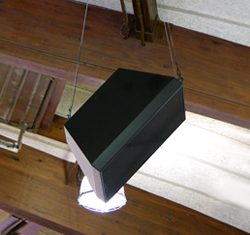
Customer: “But you silly engineer, this is a sporting event, we need to get louder than that!”
Engineer: “OK, let’s see what we can do at 85 dB SPL…We need 741 watts. This can be done, but we’re getting very close to the rated continuous power handling of the loudspeaker (1,000 watts). A good practice is to look at half the rated continuous power handling of the loudspeaker. Designing a system at full rated power is frequently done, but is not good practice.
“Now, if you only need 82 dB (still fairly loud), we need 370 watts…Easy to do. But if you need 88 dB, you will need 1,482 watts…This is NOT recommended!”
Customer: “What if I use a high Q loudspeaker, like a 60 x 40-degree dispersion instead of a 90 x40-degree dispersion? The 60 x 40-degree disperion is ‘higher Q and longer throw,’ right? I need 93 dB.”
Engineer: “What determines the ‘throw’ is the loudspeaker’s 1 watt at 1 meter rating and the power handing. In a loudspeaker, the Q of the horn will certainly alter the coverage angles but will not provide additional throw unless the 1 watt at 1 meter rating of the loudspeaker is also higher. So you will need a loudspeaker with a higher 1 watt at 1 meter rating, or higher power handling, or more loudspeakers, if you wish to get to 93 dB at 450 feet.”
Summary
Based on the examples above, the specific loudspeaker will “throw” 450 feet, no problem, or maybe a problem, or not at all. It depends on what SPL is required at a specified distance, as well as what power level is available and safe for the loudspeaker. These calculations apply to all manufacturers and to all loudspeakers.
Do some loudspeakers throw farther than others? Of course they do, and it’s easy to compare two loudspeakers based solely on the 1 watt at 1 meter sensitivity and power handling specifications.
However, asking “how far will the loudspeaker throw” (again, any loudspeaker from any manufacturer) can only be answered by asking more about the acoustic requirements of the loudspeaker and then running calculations based on those requirements and the loudspeaker’s sensitivity.
When manufacturers specifiy a “throw” distance for a loudspeaker without asking the required SPL, they’re providing incomplete or misleading information. It’s unfortunate that the term “throw” exists at all, as it frequently leads to system installations where inappropriate loudspeakers are specified for the acoustic space.
A far better question: “what SPL can I achieve at ‘X’ distance with this system and at what input power level”?
Mike O’Neill is chief engineer at One Systems and holds several patents in loudspeaker and transducer designs.
